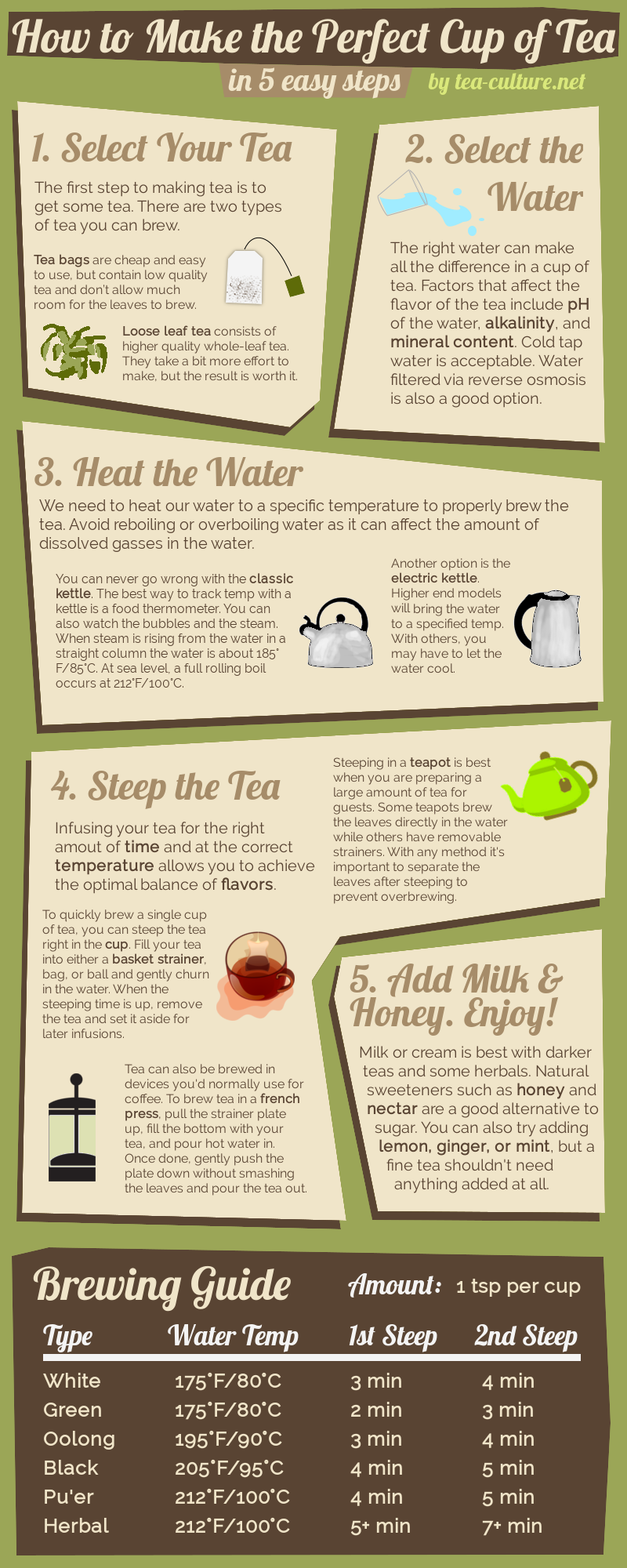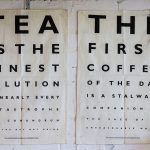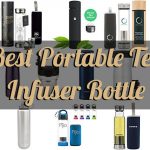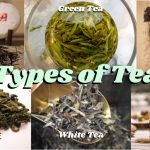Making tea can be both fun and easy when you know what to do. The hardest elements to perfect are the temperature of the water and the time to brew. But fear not, because today I am going to take you over each step of the process and show you how to brew the perfect cup of tea.
Table of Contents
Table of Contents
-
Select Your Tea
The first step of making tea is of course to get some tea. There are two types of tea you can brew:
Tea Bags
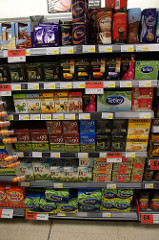
Bagged tea is primarily what you will find on grocery store shelves and accounts for a large percentage of the tea sold worldwide. Tea bags are easy to brew and dispose of, but most contain low quality tea. This tea is often machine picked and ground into a dust contaminated with twigs.
Confined space is another downside of tea bags. The leaves soak up large amounts of water as the tea brews and can block up the outside of the bag. Once this happens, leaves in the middle are cut off from water and can no longer infuse. Pyramid bags are an attempt to counter this and are made of a springy plastic mesh that stays expanded as you brew. The problem with pyramid bags is that the plastic used to make the outer mesh can leach harmful chemicals into your tea when soaked in hot water.
I have nothing against tea bags and use them myself if I’m in a hurry. Just remember that convenience comes at a cost.
Loose Leaf Tea
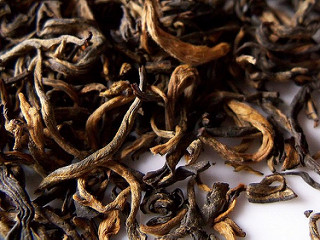
Loose Leaf Tea – CC – Yunnan Jig (close-up) by A Girl With Tea
Loose leaf tea takes a bit more effort to make, but this shouldn’t scare you away from them. Knowing the brewing process allows you to make them quickly and easily. Plus, instead of the tea dust contained in bagged tea, loose leaf tea consists of whole or partially broken tea leaves and is higher quality.
The most important thing to remember when picking a loose leaf tea is to source from the right vendors. Do your research and make sure the tea you’re buying is grown organically and picked in the right season. Yunnan Sourcing, White2Tea, and What-Cha are are all high quality vendors. Note that I am not affiliated with any of these companies. Buying loose leaf in bulk can be cheaper than buying bags because the manufacturer doesn’t have to spend money on packaging.
If you have the time and supplies, loose leaf tea is the best way to brew tea.
-
Select the Water
The right water can make all the difference in a cup of tea. Factors that affect the flavor of the tea include pH of the water, alkalinity, and mineral content. If the pH is too low your tea will taste bitter and acidic. If the pH is too high the tea will taste flat. You want water with a neutral pH, which most tap water and filtered water will have.
Metals, salts, and other minerals also play a role in the flavor of tea. Most water we drink has trace amounts of different minerals. However, we don’t want too much of any one mineral or metal because it will give an off flavor to the tea. Filtered water or freshly drawn cold tap water is usually our best option. Don’t use hot tap water because it may have been sitting in your water heater for a while and is not recommended to drink.
If you want to use a filtered water get one that was filtered via reverse osmosis. Don’t use 100% distilled water because it’s not healthy to drink and your tea will taste flat. Most filtered waters will add their own minerals back in after filtration, so pick one that tastes good to you.
-
Heat the Water
There are several methods to heat your water. Any method that gets the water hot is fine, but some are easier than others. We’ve listed them all out here for you:
Traditional Kettle
The stove top kettle is the classic way to heat water and still works well. Keep in mind that certain types of metals may affect the taste of your tea. I recommend stainless steel, which most kettles are made from.
Always avoid reusing/reboiling the same water. It’s best to start with an empty kettle and pour in what you will use. Reboiling affects the levels of certain dissolved gasses in the water that can affect the taste of the tea.
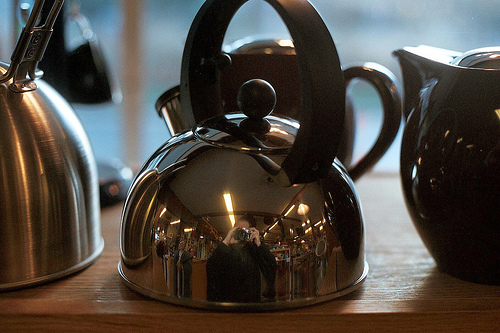
Stainless Steel Kettle – CC – Self-portrait in kettle by Logan Ingalls
To keep track of the temperature of the water as it’s heated your best option is to use a food thermometer. If you don’t have a food thermometer you can also use the bubbles and steam as an indicator of temperature. The Chinese even have a specific method of using the size and movement of the bubbles to tell how hot the water is. Another simple trick is to open the top of the kettle and watch the steam. Once it comes up in a continuous column, the water has reached 180°F/82°C.
Electric Kettle
The easiest way to heat water is with an electric kettle. More expensive models will bring water to a desired temperature. If you want to splurge and get one that allows precise control of the temperature, you can’t go wrong with the Bonavita. Buying through that link will help support the site. Most electric kettles just bring the water to a boil. Once the water is boiling, pour it out into a teapot and let it cool. Simply pouring it into a cool teapot will bring the water down 10-15 degrees fahrenheit. To measure the temperature of the water you can use a food thermometer, or you can just wait and watch the steam.
If you don’t have a kettle but are dying for a cup of tea, heat the water in a clean pan over the stove.
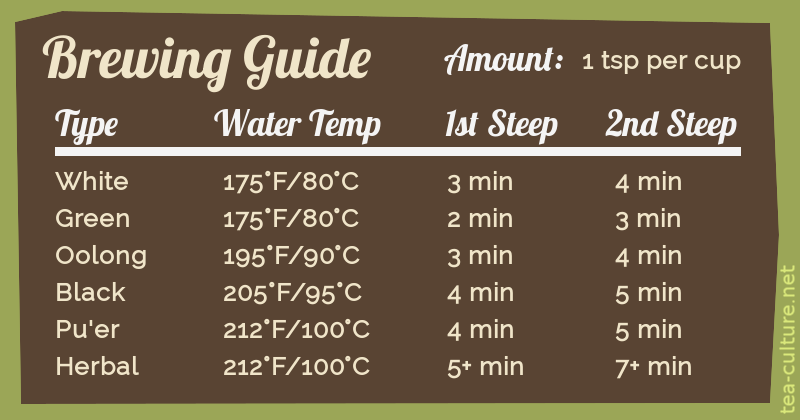
-
Steep the Tea
Infusing your tea for the right amout of time and at the correct temperature allows you to achieve the optimal balance of flavors. Different chemicals within the tea leaves are soluable in water at different temperatures. Many Japanese green teas are brewed at much lower temperatures than other teas to maximize the content of the amino acid theanine, while minimizing bitter compounds such as tannic acid. On the other hand, a higher temperature is needed to extract many of the volatile aromatic compounds found in darker teas.
There are many ways to infuse tea leaves. The purpose of any extraction method is to expose as much of the tea leaves to your hot water as possible. Listed below are the more common methods used for steeping. One thing to note before you brew is that darker teas and pu Ehrs are generally rinsed with hot water before being brewed. This helps to unfurl the leaves and start the infusion, but it also washes away any tea dust or other particulates that you may not want in your tea.
In the Cup
The fastest way to a cup of tea is to brew the tea right in the cup. This method can be ideal if your are by yourself and just need to make a single cup. To create the best cup of tea you will want to use a basket strainer with loose leaf tea inside because they allow the most room for your tea to expand and infuse. The next best option is loose leaf tea inside a bag or a ball, but a pre-filled bag works as well.
Once you have the tea in it’s container and a cup of hot water, dip it in and gently churn the tea for the duration of the brew. This churning is not strictly necessary but it’s kind of fun and it helps with the infusion. When the time is up, pull your tea out. If you’re using a pre-filled bag, throw it out because they are only good for a single infusion, but if you have a loose leaf tea they can be set aside for subsequent infusions. I usually set my basket strainer on a small plate so the water doesn’t leak.
Teapot
Steeping in a teapot is best when you are preparing a large amount of tea for guests or for yourself. This method also has a more ceremonious feel to it. Speaking of ceremonious, the Chinese have their own special method of preparing tea called gongfu. I will cover that method in a later article. For now, let’s look at the fundamentals.
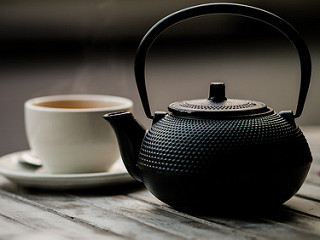
Tea for one by KARL-SEBASTIAN SCHULTE
There are countless variations on the teapot, but most fall into one of two categories. The first category of teapot is the kind that have a built in basket strainer. This strainer holds the tea while the water sits in the basin of the pot. Once the tea is done infusing the strainer can be removed from the pot and set aside for later infusions. The second category are teapots that hold the leaves and water together and filter the leaves as the tea is poured. This type of teapot is common in Asian cultures such as the Japanese kyusu and the Chinese gaiwan.
When the tea is done infusing, the water and leaves need to be separated or the tea will become over brewed. If your are using a teapot with a removable strainer, the whole strainer can be removed and set aside for later infusions. In teapots with no strainer, the water has to be poured out either straight into your teacups, or into a secondary holding cup.
French Press & Coffee Maker
Tea and coffee share some similarities with coffee in the way they are brewed. While not necessarily recommended, this means that tea can be brewed with devices you’d typically use for coffee.
To brew tea in a french press, pull the strainer plate up, fill the bottom with your tea, and pour hot water in. Keep the plate extended until you are done brewing and then gently press it down. The tea is now ready and it’s recommended to pour it off into another container right away to avoid further brewing. For subsequent infusions, lift the strainer plate and repeat.
Brewing tea in a coffee maker feels wrong but can be done if needed. Most drip coffee makers heat the water to about 200°F/93°C and are thus better suited for darker teas such as oolongs and blacks. Load the tea just as you would coffee and let it brew. If you have a teabag or strainer you can also leave the coffee basin empty and let the coffee maker heat the water for you.
-
Add Milk & Honey and Enjoy
You don’t need anything extra to enjoy a cup of tea and finer tea’s are often better drunk alone. That being said, sometimes extra ingredients can add a complimentary touch.
Milk is best added to darker teas and some herbal blends. The creaminess helps take off some of the bitter edge. If you’re concerned about calories, a low fat milk can be a good alternative. Avoid using any kind of milk or cream in green and white teas as it overpowers the light floral notes. The proteins in milk also bind to antioxidant catechins in green tea and deactivate them.
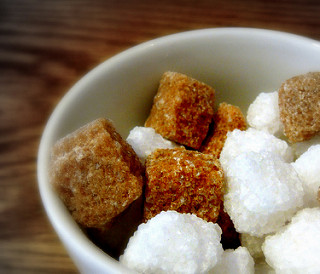
Sugar Cubes by Kurtis Garbutt
Many people also enjoy their tea sweetened with a bit of sugar. A little bit is fine, but too much and you will mask the subtle notes in the tea. Better alternatives to sugar include raw honey and fruit nectar or syrup.
Other natural flavors that compliment tea well include lemon, mint, ginger, and cinnamon. Every tea is different so experiment on your own to see what flavors go well together. Now, sit back and enjoy the fruits of your labor.

